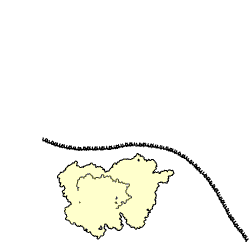
Back Eco de espín de neutrones Spanish Spectroscopie neutronique à écho de spin French Neutronspinekhó Hungarian
| Science with neutrons |
|---|
 |
| Foundations |
| Neutron scattering |
| Other applications |
|
| Infrastructure |
|
| Neutron facilities |
Neutron spin echo spectroscopy is an inelastic neutron scattering technique invented by Ferenc Mezei in the 1970s and developed in collaboration with John Hayter.[1] In recognition of his work and in other areas, Mezei was awarded the first Walter Haelg Prize in 1999.[citation needed]
In magnetic resonance, a spin echo is the refocusing of spin magnetisation by a pulse of resonant electromagnetic radiation. The spin echo spectrometer possesses an extremely high energy resolution (roughly one part in 100,000). Additionally, it measures the density-density correlation (or intermediate scattering function) F(Q,t) as a function of momentum transfer Q and time. Other neutron scattering techniques measure the dynamic structure factor S(Q,ω), which can be converted to F(Q,t) by a Fourier transform, which may be difficult in practice. For weak inelastic features S(Q,ω) is better suited, however, for (slow) relaxations the natural representation is given by F(Q,t). Because of its extraordinary high effective energy resolution compared to other neutron scattering techniques, NSE is an ideal method to observe[2] overdamped internal dynamic modes (relaxations) and other diffusive processes in materials such as a polymer blends, alkane chains, or microemulsions.

The extraordinary power of NSE spectrometry[3] was further demonstrated recently[4][5] by the direct observation of coupled internal protein dynamics in the proteins NHERF1 and Taq polymerase and the adherens junction,[6] allowing the direct visualization of protein nanomachinery in motion.[7] Several elementary reviews of the technique exist.[8][9][10][11][12]
.
- ^ Mezei, F., ed. (1980). Neutron Spin Echo. Lecture Notes in Physics Vol. 128. Berlin, Heidelberg, New York: Springer.
- ^ B. Farago (2006). "Neutron spin echo study of well organized soft matter systems". Physica B. 385–386: 688–691. Bibcode:2006PhyB..385..688F. doi:10.1016/j.physb.2006.05.292.
- ^ Callaway, D. J.; Farago, B; Bu, Z (2013). "Nanoscale protein dynamics: A new frontier for neutron spin echo spectroscopy". The European Physical Journal E. 36 (7): 76. doi:10.1140/epje/i2013-13076-1. PMID 23884624. S2CID 10246098.
- ^ B. Farago, Li J, Cornilescu G, Callaway DJE, Bu Z (November 2010). "Activation of Nanoscale Allosteric Protein Domain Motion Revealed by Neutron Spin Echo Spectroscopy". Biophysical Journal. 99 (10): 3473–3482. Bibcode:2010BpJ....99.3473F. doi:10.1016/j.bpj.2010.09.058. PMC 2980739. PMID 21081097.
{{cite journal}}: CS1 maint: multiple names: authors list (link) - ^ Bu Z, Biehl R, Monkenbusch M, Richter D, Callaway DJE (2005). "Coupled protein domain motion in Taq polymerase revealed by neutron spin-echo spectroscopy". Proc Natl Acad Sci USA. 102 (49): 17646–17651. Bibcode:2005PNAS..10217646B. doi:10.1073/pnas.0503388102. PMC 1345721. PMID 16306270.
{{cite journal}}: CS1 maint: multiple names: authors list (link) - ^ Farago B, Nicholl ID, Wang S, Cheng X, Callaway DJ, Bu Z (March 30, 2021). "Activated nanoscale actin-binding domain motion in the catenin-cadherin complex revealed by neutron spin echo spectroscopy". Proc Natl Acad Sci USA. 118 (13): e2025012118. Bibcode:2021PNAS..11825012F. doi:10.1073/pnas.2025012118. PMC 8020631. PMID 33753508.
- ^ Callaway DJ, Nicholl ID, Shi B, Reyes G, Farago B, Bu Z (2024). "Nanoscale dynamics of the cadherin-catenin complex bound to vinculin revealed by neutron spin echo spectroscopy". Proceedings of the National Academy of Sciences of the United States of America. 129 (39). doi:10.1073/pnas.2408459121. PMC 11441495. PMID 39298480.
- ^ L. Kay Nicholson (1981). "The neutron spin-echo spectrometer: A new high resolution technique in neutron scattering". Contemp. Phys. 22 (4): 451–475. Bibcode:1981ConPh..22..451N. doi:10.1080/00107518108231544.
- ^ Higgins JS, Benoit HC (1997). Polymers and neutron scattering. Oxford Series on Neutron Scattering in Condensed Matter (Book 8). Clarendon Press. ISBN 978-0198500636.
- ^ Callaway DJ, Bu Z (2017). "Visualizing the nanoscale: protein internal dynamics and neutron spin echo spectroscopy". Curr. Opin. Struct. Biol. 42: 1–5. doi:10.1016/j.sbi.2016.10.001. PMC 5374024. PMID 27756047.
- ^ Richter D (2006). "Neutron spin echo for the exploration of large scale macromolecular dynamics". J. Phys. Soc. Jpn. 75 (11): 110041–11004112. Bibcode:2006JPSJ...75k1004R. doi:10.1143/JPSJ.75.111004.
- ^ Jacrot, B (1976). "The study of biological structures by neutron scattering from solution". Reports on Progress in Physics. 39 (10): 911–53. Bibcode:1976RPPh...39..911J. doi:10.1088/0034-4885/39/10/001. S2CID 250751286.
© MMXXIII Rich X Search. We shall prevail. All rights reserved. Rich X Search